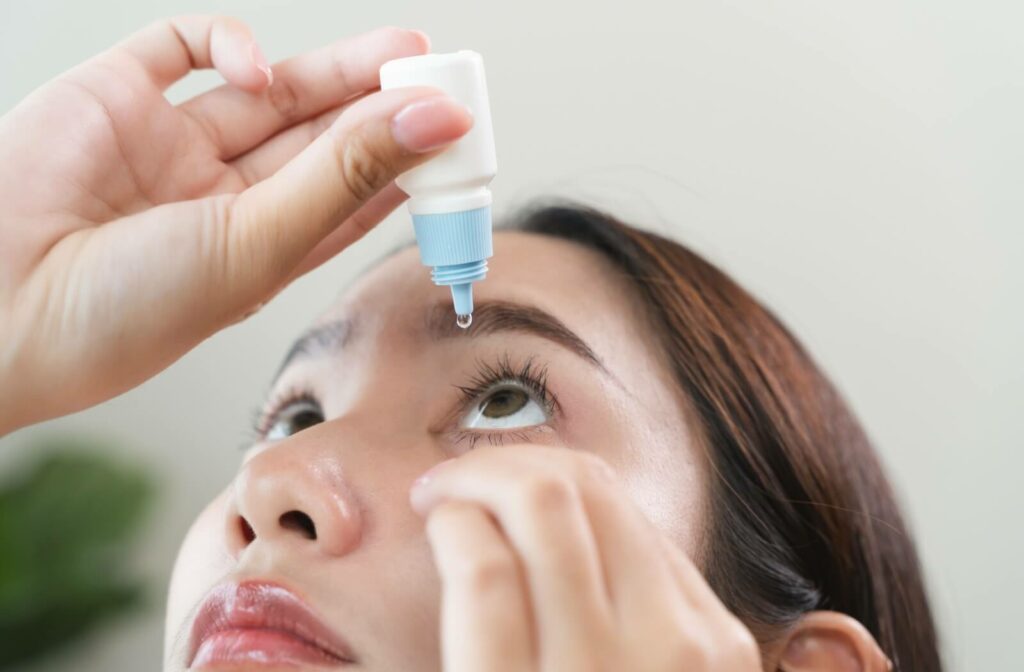Headaches can have many different causes—stress, dehydration, even posture. When they occur alongside sore, irritated eyes, it’s easy to wonder if dry eye is to blame. While dry eye may not directly cause headaches, factors like screen time, poor lighting, or fatigue can contribute to headaches, making them feel connected even if the link isn’t fully understood.
If you’re dealing with these symptoms regularly, comprehensive eye exams can help uncover what’s really going on and provide relief that lasts.
What Is Dry Eye?
Dry eye occurs when your eyes don’t produce enough tears, or when the quality of your tears isn’t quite right to keep your eyes properly hydrated. A healthy tear film plays an essential role in clear, comfortable vision—it helps wash away debris, reduces the risk of infection, and keeps eye movements smooth. When this delicate balance is disrupted, your eyes may feel dry, irritated, gritty, or even blurry.
While dry eye can sometimes be temporary, chronic cases often require long-term care. If left unmanaged, dry eye can affect your everyday comfort and overall eye health. Understanding what’s causing your symptoms is the first step toward relief, and A comprehensive eye exam can help identify the best course of action tailored to your individual needs.
What Causes Dry Eye?
There isn’t one single cause of dry eye. Instead, several factors can play a role. Here are some of the most common ones we see:
Age & Hormonal Changes
As we get older, tear production naturally declines—especially after age 50. Hormonal shifts, particularly during menopause, can affect how much oil or water your eyes produce, leaving the tear film unstable and the eyes feeling persistently dry.
Although aging is a part of life, dry eye doesn’t have to be. Staying hydrated, using lubricating drops, and scheduling regular eye exams can help manage age-related symptoms effectively.
Prolonged Screen Time
When we’re glued to screens—whether working, gaming, or scrolling—we tend to blink less often. This can cause the tear film to evaporate, leading to digital eye strain. That’s why dry eye is so common among people who spend a lot of time on computers or smartphones.
Environmental Factors
Living in a dry climate? Working in a heavily air-conditioned space? Windy days, air-conditioned or heated spaces can cause tear evaporation. Exposure to smoke, dust, or pollen can also aggravate symptoms and make your eyes feel even more uncomfortable.
Medications
A number of common medications—including antihistamines, antidepressants, blood pressure medications, and diuretics—can impact your tear production. These medications can either reduce tear volume or alter the tear film’s balance.
If you think your medication may be contributing to dry eye, speak with your doctor or optometrist about possible alternatives or supportive treatments.
Contact Lens Use
Wearing contact lenses can interfere with your tear film and draw moisture out of your eyes. Long wear times or improper cleaning habits can make things worse.
Switching to daily disposable lenses, using rewetting drops, or alternating with glasses can often help. If dry eye continues, you might benefit from specialty contact lenses or other tailored options—ask your optometrist and find out what’s recommended for you.
Underlying Health Conditions
Certain autoimmune diseases—like Sjögren’s syndrome, rheumatoid arthritis, and lupus—can reduce your ability to produce healthy tears. Other conditions, such as diabetes or thyroid disorders, may also affect your tear glands.
Even skin conditions such as rosacea can impact the oil-producing glands in your eyelids, accelerating tear evaporation. Addressing these underlying health issues can help you manage chronic dry eye more effectively.
For a closer look at what might be causing your symptoms, an optometrist can provide eye disease diagnosis and personalized care.

Common Symptoms of Dry Eye
Dry eye symptoms can vary from person to person, but often include:
- Redness and irritation: Eyes may feel sore, itchy, or appear bloodshot.
- Burning or stinging: A sign your eyes are lacking proper lubrication.
- Blurred vision: Especially noticeable after tasks like reading or screen use.
- Watery eyes: Your body may overcompensate with extra (but low-quality) tears.
- Gritty or sandy feeling: Like something’s always stuck in your eye.
- Light sensitivity: Bright light can feel harsh or even painful.
Left unmanaged, dry eye symptoms can contribute to eye strain—a contributor to headaches. If your at-home treatments aren’t helping, don’t wait. Reach out to an optometrist for an assessment and professional guidance.
How Do Dry Eyes Relate to Headaches?
While dry eyes may not directly cause headaches, straining to focus with irritated eyes can lead to muscle fatigue around the eyes and forehead, sometimes resulting in tension headaches.
For those prone to migraines, light sensitivity associated with dry eyes may act as a trigger. Additionally, irritation of the cornea’s nerve endings can send pain signals to the brain that may manifest as headaches.
Find Long-Term Relief with Personalized Dry Eye Care
Dry eye can be more than just a daily annoyance—it can affect your focus, comfort, and even contribute to recurring headaches. Whether your issues are linked to screen time, aging, or your environment, finding the root cause is key to lasting relief. With the right care, you don’t have to settle for irritation or blurry, strained vision.
At Vivid Eye Care, we offer personalized dry eye therapy and thorough comprehensive eye exams to help you feel comfortable and see clearly. Book your appointment today—we’re here to help make you feel taken care of.






















